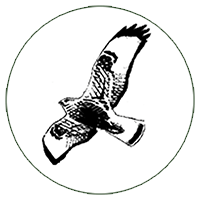
Birders Journal
The Magazine For Canadian Birders
1991- 2004
Southern Albatrosses In North American Waters
by Steven G. Mlodinow
Albatrosses seize the imagination. They signify mystery and mobility, wide-open spaces and unknown territory. They inspire introspection on one hand and wanderlust on the other. So strange and fantastic was the albatross’s apparition to early European mariners that they believed these birds’ bodies harboured the souls of dead sailors. To kill one was to be cursed. Modern day birders aren’t quite as awed by the sight of an albatross, but the appearance of a vagrant albatross does create a reaction that is far from calm.
Eight species of albatrosses have occurred in North American waters, five of which are considered vagrants (American Ornithologists Union [AOU] 1998): Yellow-nosed Albatross Thalassarche chlororhynchos, Shy Albatross T.cauta, Black-browed Albatross T.melanophris, Light-mantled Albatross Phoebetria palpebrata, and Wandering Albatross Diomedea exulans. Each of these species has made it to North American waters from the Antarctic or other regions far south of the equator.
Identification of female Cassins’s and Purple Finches
by Alvaro Jaramillo and David Beadle
The genus Carpodacus which includes the Purple, Cassin’s and House finches of North America and many Asian species, consists of sexually dimorphic birds with males showing obvious red on the plumage while the females are duller, brown and streaked. This article deals largely with the separation of Purple Finch C.purpureus and Cassin’s Finch C.cassinii in this duller streaked plumage. House Finch C.mexicanus will be dealt with at a lesser level of detail as it is not nearly as difficult an identification problem. Purple and Cassin’s finches are closely related “sister species” while House Finch is genetically quite distant from them (Marten and Johnson 1986).
Identification of Yellow-bellied and “Western” Flycatchers
by Matt Heindel and Peter Pyle
Identifying Empidonax flycatchers has been very difficult for most birders. Indeed, only in the past decade or so has the field identification of this genus become a widespread practice. A series of articles in Birding by Whitney and Kaufman (e.g., 1986), and then Kaufman (1990), helped bring the identification criteria to a larger number of observers. Even with this knowledge, birders should remain conservative in identifying every Empidonax flycatcher they encounter, and should be particularly cautious when claiming one out of range.
Field Identification of Archilochus Hummingbirds
by Steve N. G. Howell
Hummingbirds present some of the most challenging identification problems in North America. Views of these tiny, fast-flying birds in the field are often frustratingly brief, and many hummingbirds simply “get away” as unidentified – even for experienced birders. Accepting that most of your field encounters with hummingbirds may be this way is an important first step! Fortunately, hummingbird feeders increasingly allow close-range and prolonged studies that are difficult if not impossible to obtain “in the wild,” but then, if you do see a bird well, what do you look for? Females and immatures of different species, and even adult males, often look very similar to one another. Indeed, plumage differences between ages and sexes of the same species can be greater than those between species.
Baird’s Sparrow – Migration, Vagrancy, and Identification
by Jon L. Dunn
Few species are more poorly known as a migrant than is the Baird’s Sparrow Ammodramus bairdii. Most birders will have seen Baird’s Sparrows on their breeding grounds in the northern Great Plains, some may have seen them on the winter grounds, where usually considerable effort is required to get a good view, but only a small number, and even fewer reliably, have seen an actual migrant of this species.
A Hybrid Sandpiper in Newfoundland
by Bruce Mactavish and Ken Knowles
On November 8, 2003 Ken Knowles and Bruce Mactavish were birding Bear Cove on the southeast corner of the Avalon Peninsula. Renowned for vagrant passerines, this site also has a short gravel beach where a build-up of rotting kelp attracts small numbers of shorebirds. Ken had reported seeing a Buff-breasted Sandpiper on the beach and, realizing how late such a record would be in North America, I had to see the bird.
Labrador’s Common Snipe – A review of Canada’s only record of Common Snipe
by Matt Holder and Jeremiah Trimble
The American Ornithologists’ Union (AOU) published their decision to regard American populations of Common Snipe as distinct (Banks et al. 2002). What was once the North American subspecies Gallinago gallinago delicata has been elevated to species status G. delicata and given the English name Wilson’s Snipe, while the Old World taxon retains the English and scientific names of Common Snipe and G.gallinago, respectively. As a result of this split, the Birders Journal List of Canadian Birds was updated, and a decision was made to retain the Old World’s Common Snipe on the List based on a historical specimen record from Labrador (Holder 2003). This article provides background and a description of Canada’s first record of Common Snipe.
The Identification and Migration of Breeding Plumaged Dowitchers in Southern Ontario
by Alvaro Jaramillo, Ron Pittaway and Peter Burke
Dowitcher taxonomy and identification have caused a great deal of confusion in the past. Originally, the Long-billed Dowitcher Limnodromus scolopaceus and Short-billed Dowitcher Limnodromus griseus were described as different species. Due to the frequent observations of birds that appeared to be intermediate, the two forms were lumped (Bent 1927). In 1932 W.Rowan published a paper describing the newly discovered breeding population of Short-billed Dowitchers in Alberta and Manitoba. He decided that these bright looking birds were worthy of subspecific recognition, L.g.hendersoni (Rowan 1932). He also concluded that Long-billed Dowitcher was a separate species, partly because birds identified as intermediates were actually L.g.hendersoni.
